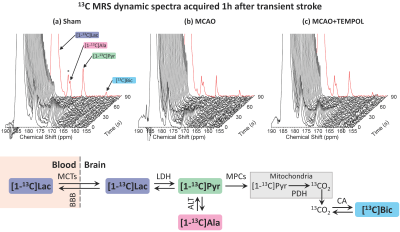Thanh Phong Lê1,2, Lara Buscemi3, Mario Lepore4, Lorenz Hirt3, Jean-Noël Hyacinthe1,5, and Mor Mishkovsky2
1Geneva School of Health Sciences, HES-SO University of Applied Sciences and Arts Western Switzerland, Geneva, Switzerland, 2Laboratory of Functional and Metabolic Imaging, EPFL (Swiss Federal Institute of Technology in Lausanne), Lausanne, Switzerland, 3Department of Clinical Neurosciences, Lausanne University Hospital (CHUV) and University of Lausanne (UNIL), Lausanne, Switzerland, 4Center for Biomedical Imaging (CIBM), EPFL, Lausanne, Switzerland, 5Image Guided Intervention Laboratory, University of Geneva (UNIGE), Geneva, Switzerland
1Geneva School of Health Sciences, HES-SO University of Applied Sciences and Arts Western Switzerland, Geneva, Switzerland, 2Laboratory of Functional and Metabolic Imaging, EPFL (Swiss Federal Institute of Technology in Lausanne), Lausanne, Switzerland, 3Department of Clinical Neurosciences, Lausanne University Hospital (CHUV) and University of Lausanne (UNIL), Lausanne, Switzerland, 4Center for Biomedical Imaging (CIBM), EPFL, Lausanne, Switzerland, 5Image Guided Intervention Laboratory, University of Geneva (UNIGE), Geneva, Switzerland
The
nitroxyl TEMPOL radical, administered at the same dose as when used as DNP polarizing
agent, significantly modifies
the cerebral metabolic response to a bolus of hyperpolarized [1-13C]lactate
after transient ischemic stroke.

Figure 2: Representative dynamic cerebral 13C MRS
acquired after a bolus infusion of [1-13C]lactate (lb=10Hz).
The summed signal from the first 90s post-infusion is plotted in red. The
vertical scale was normalized to the height of the summed HP lactate peak. In
both healthy and stroke animals, the HP lactate was converted into [1-13C]pyruvate
(171.1 ppm), [1-13C]alanine (176.7 ppm) and [13C]bicarbonate
(161.2 ppm). The signal observed at 177.7 ppm (*) is an impurity from the
stock lactate solution.

Figure 3: Metabolite ratios following HP lactate infusion at 1h
post-surgery or post-reperfusion. Data are represented as mean ± SD.
(a) Following infusion of
[1-13C]lactate, the normalized pyruvate-to-lactate ratio (cPLR) was
significantly lower in the MCAO group compared to both sham and MCAO+TEMPOL
groups. (b) A trend towards lower alanine
labeling (cALR) was observed after stroke, with a significant difference
between MCAO+TEMPOL and sham.
(c) The bicarbonate-to-lactate ratio (cBPR) tends to decrease after stroke.
